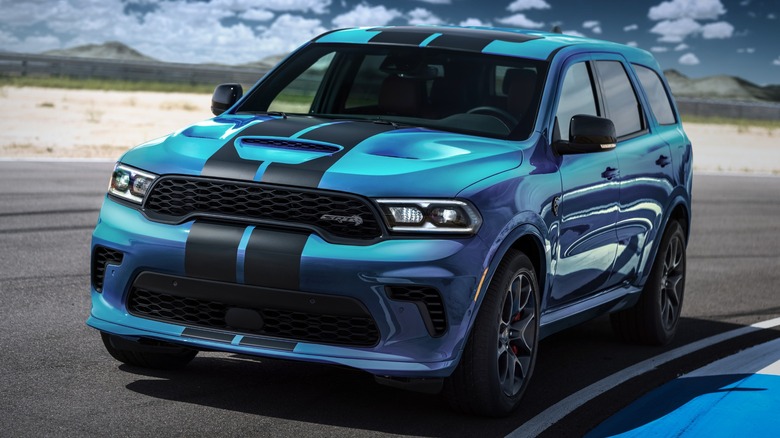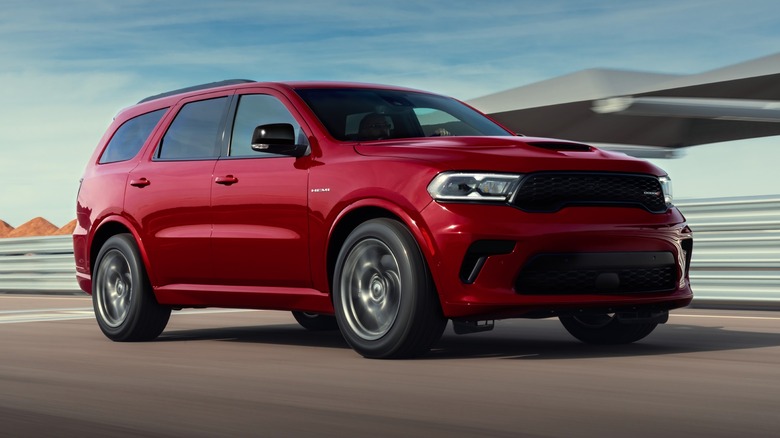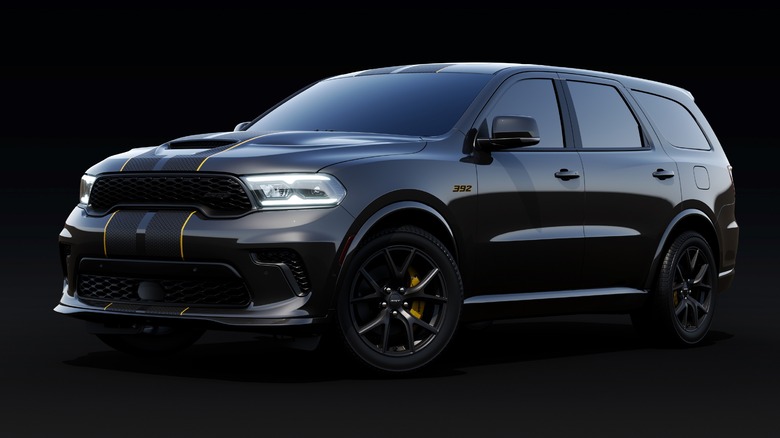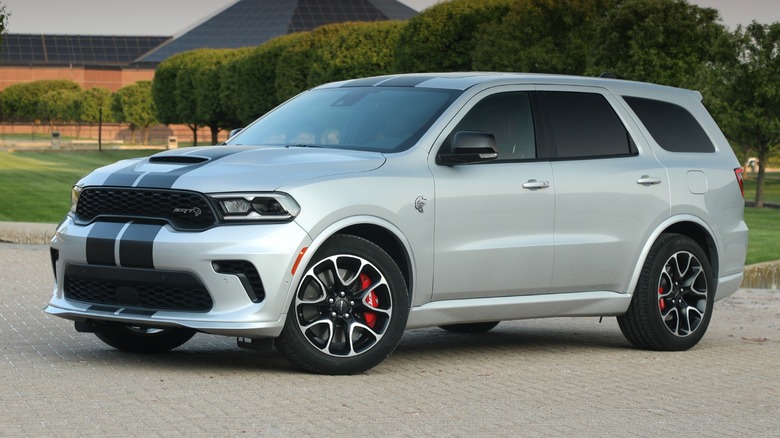What's The Difference Between The Dodge Durango R/T Vs. SRT?
When it comes to Dodge, offering high-performance trims for vehicles like the Charger or the Challenger is a no-brainer. These are vehicles with a history that goes back to the heyday of American muscle cars, which were able to flourish due to large, powerful V8 engines underneath the hood. Although the cars have had their ups and downs — even including being out of production for many years — the image of these Dodges tearing down the street remains indelible to the company's legacy.
However, Dodge does not just make these muscle cars — it also has SUVs on its production line, such as the mid-size Dodge Durango first introduced for the 1998 model year. The automaker doesn't limit its high-performance trims just to its smaller vehicles, and as such, the Durango can be outfitted with much of the same equipment as the Challenger or Charger. Among the 15 trims available for the SUV are the R/T and SRT models, both of which have long been a staple of Dodge and other brands under the Stellantis umbrella.
What is the Dodge Durango R/T?
The Dodge Durango R/T is a well-liked model here at SlashGear. The name is an abbreviation for Road and Track and has been a label the company has used all the way back to the 1967 Dodge Coronet. This is a performance package designed for a vehicle to straddle the line between an everyday production car and one you could imagine tearing up your local racetrack.
With the most recent models, the standard SXT Durango features a 3.6L Pentastar V6 engine, but the R/T trim upgrades that to the larger 5.7L HEMI V8, which is able to generate 360 hp. After the 2024 model year, Stellantis is doing away with the HEMI V8 engines entirely, and there has not yet been an official announcement as to what will replace it in the Durango R/T. If the forthcoming 2025 Charger R/T is any indication, we may be looking at an all-electric Durango EV in the future.
Unlike some other Dodge Durango trims, the R/T allows you to choose between rear-wheel and all-wheel drive options. The fuel economy is decent, with a combined 17 mpg (14 city mpg and 22 highway mpg). This trim for the Durango is meant to serve that perfect middle ground of what someone could want out of an SUV, and with a starting price of $51,270, it fits right in line with being a performance package that doesn't go overboard.
What is the Dodge Durango SRT?
The R/T trim was a moderate upgrade to the standard SXT Dodge Durango, but the SRT trim takes that to a whole different level. Although the division that created the SRT branding started back in 1989, that name didn't really take off until the mid-2000s, which stands for Street and Racing Technology. If all you care about is a high-performance Dodge, then getting one with an SRT badge is the way to go. As for the SUV, the Dodge Durango SRT 392, as it's officially named, replaces that 5.7L HEMI V8 from the R/T trim with the even larger 6.4L HEMI V8 — or 392 cu. in. of displacement, hence the name — for an impressive output of 475 hp. Once again, production on HEMI engines is wrapping up very soon, and Dodge is commemorating this with the last call Durango AlcHEMI edition. As for the 2025 model and beyond, they could very well be all-electric as well.
Unlike the R/T, the SRT model is only available with an all-wheel drive configuration. This larger engine means you are also going to fall behind a bit on fuel economy. With 13 mpg in the city and 19 mpg on the highway, you are looking at a combined 15 mpg, which isn't exactly anyone's idea of an efficient vehicle. However, even though this is a seven-passenger SUV, the SRT trim makes it clear that power is clearly what is most important, and with a starting price of $74,995, you are certainly paying a premium for that power.
Many different R/T and SRT variations
It would be nice if the R/T and SRT models of the Dodge Durango stopped there, but things get a bit more complicated from here. There are actually three different R/T models for the Durango: the R/T, R/T Plus, and R/T Premium. The upgrades that you would get with each subsequent trim level have more to do with luxury features than performance, as there are no other engine options available beside the 5.7L HEMI V8. Instead, you are looking at upgrades to seating, sound systems, and safety features. These Plus and Premium options take their cues from the Durango Citadel as much as they do the R/T trim. Each subsequent trim level sees an increase to the base starting price by roughly $3,000 or so.
When it comes to the SRT 392 models, there are six more different trim variants. Like the R/T trim, you have the standard, Plus, and Premium variations that see luxury upgrades the higher you go. Alongside that, though, you have the SRT Hellcat models. These models take out that 6.4L HEMI V8 and replace it with a supercharged 6.2L HEMI V8 for the ultimate power trip, generating a whopping 710 hp. Naturally, these see a big increase in price too, starting out at $95,995, and the Hellcat models also have the triptych of standard, Plus, and Premium options available, with the Hellcat Premium starting at over $107,000.
If you are looking for a higher performance Dodge Durango, the company has made it easy to find the right SUV for you at whatever your budget may be.



